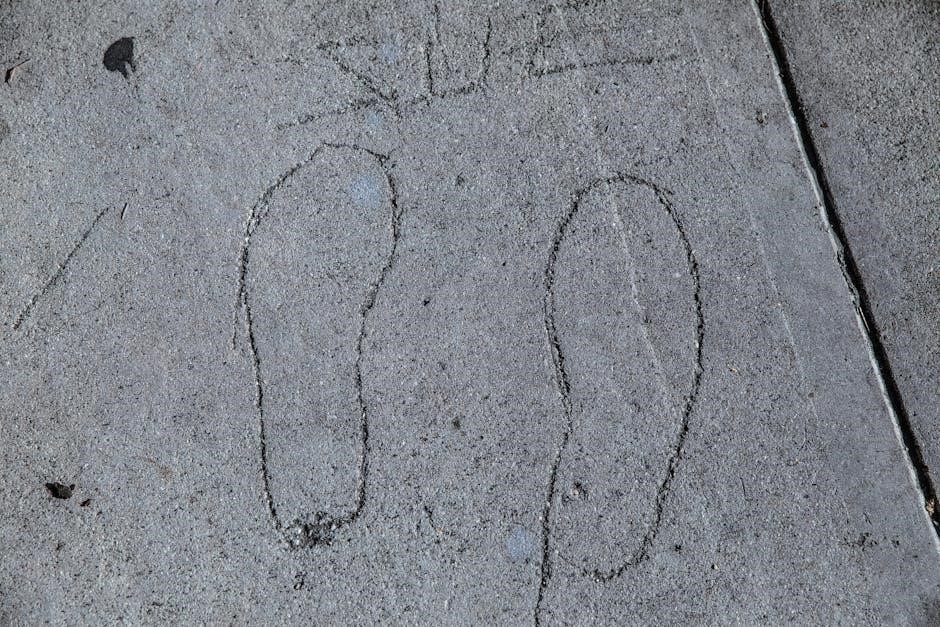la bailarina de auschwitz pdf
- by laurianne

La Bailarina de Auschwitz by Edith Eger is a haunting yet inspiring memoir about survival, resilience, and hope during one of history’s darkest periods․ Available as a PDF, the book shares Eger’s extraordinary journey through Auschwitz, highlighting her courage and the transformative power of dance․
Background and Significance of the Book
La Bailarina de Auschwitz, written by Edith Eger, is a deeply moving memoir that recounts her harrowing experiences during the Holocaust; The book, available as a PDF, delves into her time in Auschwitz, where dance became a symbol of hope and resilience․ Eger’s story is not only a testament to human endurance but also a powerful exploration of trauma, healing, and forgiveness․ The book’s significance lies in its raw honesty and its ability to inspire readers with its message of survival and the triumph of the human spirit․ It has resonated globally, becoming an essential read for understanding Holocaust history․
The Author: Edith Eger
Edith Eger, a Holocaust survivor and renowned psychologist, is the author of La Bailarina de Auschwitz․ Born in Hungary, Eger endured unimaginable horrors at Auschwitz before rebuilding her life․ Her memoir, available as a PDF, offers a unique perspective on trauma, resilience, and forgiveness․ Eger’s work as a psychologist and her advocacy for Holocaust awareness have made her a respected voice globally․ Her story, both deeply personal and universally inspiring, has captivated readers, highlighting the strength of the human spirit․ Through her writing and public speaking, Eger continues to educate and inspire, making her one of the most important voices of our time․
The Title: Meaning and Symbolism
The title La Bailarina de Auschwitz carries profound symbolism, reflecting Edith Eger’s journey․ Dance, a symbol of joy and freedom, contrasts sharply with the horrors of Auschwitz, highlighting her resilience․ The title encapsulates her survival story, where dance became a source of hope and strength․ Available as a PDF, the book explores how dance transcended the brutality of the concentration camp, offering a glimpse into the human spirit’s capacity for survival and healing․ The title thus serves as a powerful metaphor for finding light in darkness and the enduring power of hope amidst unimaginable suffering․

Edith Eger’s Early Life
Edith Eger grew up in a loving family, fostering her early passion for dance, which later became a source of strength during her harrowing experiences in Auschwitz․
Childhood and Family Background
Edith Eger was born into a close-knit Jewish family in Hungary, surrounded by love and cultural richness․ Her parents, though not wealthy, nurtured her early talents and aspirations, particularly in dance, which became a central part of her identity․ This supportive environment provided her with the resilience needed to face the unimaginable challenges ahead․ Her family’s emphasis on education and the arts laid the foundation for her strength and determination, qualities that would help her survive the horrors of Auschwitz․
Early Passion for Dance
Edith Eger’s passion for dance began at a young age, becoming her escape and joy․ She trained tirelessly, mastering ballet and ballroom techniques, with her talent quickly setting her apart․ Dance was not just a hobby but a deep expression of her spirit, offering her freedom and confidence․ Even in the darkness of Auschwitz, her love for dance became a lifeline, providing solace and hope․ Her early dedication to this art form laid the groundwork for its role in her survival, as she later used dance to uplift herself and others in the camp․
Relocation to Auschwitz
Edith Eger’s life drastically changed when she and her family were forcibly relocated to Auschwitz during the Holocaust․ The harrowing journey in cramped cattle cars, with little food or water, marked the beginning of unimaginable suffering․ Upon arrival, the harsh reality of the concentration camp hit her, as she witnessed the brutal separation of families and the dehumanizing conditions․ Despite the chaos and fear, Eger’s resilience began to emerge, setting the stage for her survival story․ This relocation was the start of a chapter that would test her strength and ultimately shape her future․

Life in Auschwitz
La Bailarina de Auschwitz vividly portrays Edith Eger’s harrowing experiences in the concentration camp, where she faced relentless hardship, fear, and despair․ Dance became her unexpected lifeline, offering fleeting solace amidst unimaginable suffering․
Arrival and Initial Experiences
Edith Eger’s arrival at Auschwitz marked the beginning of unimaginable horror․ The chaos, brutality, and dehumanizing conditions left her shattered․ Separated from her family, she witnessed the Nazi regime’s ruthlessness firsthand․ The initial days were filled with fear, uncertainty, and the struggle to survive; Despite the despair, Edith found solace in dance, a coping mechanism that became a lifeline during her ordeal․ Her story, detailed in La Bailarina de Auschwitz, highlights the resilience of the human spirit even in the darkest of times, offering a powerful narrative of hope and survival available for readers worldwide in PDF format․
Daily Life in the Concentration Camp
Daily life in Auschwitz was a relentless struggle for survival․ Edith Eger endured harsh conditions, including overcrowded barracks, meager rations, and exhausting labor․ The constant threat of death loomed over her, and the psychological toll of living in terror was immense․ Despite the brutality, Edith found moments of solace through dance, which became a source of strength and hope․ Her story, as shared in La Bailarina de Auschwitz, vividly portrays the resilience of the human spirit․ The book, available in PDF, offers a poignant glimpse into the daily horrors and the extraordinary courage required to endure them․
Role of Dance in Survival
Dance played a pivotal role in Edith Eger’s survival in Auschwitz․ It served as a source of strength, providing emotional escape and resilience amidst unimaginable hardships․ Through dance, Edith found moments of joy and hope, which helped her maintain her humanity․ Her story, detailed in La Bailarina de Auschwitz, highlights how dance became a lifeline, allowing her to transcend the horrors around her․ The book, available as a PDF, shares how this creative expression not only sustained her spirit but also inspired others, demonstrating the powerful impact of dance in preserving hope during one of history’s darkest periods․

Libération and Aftermath
The liberation marked the beginning of Edith Eger’s journey toward healing․ Physical and emotional recovery were challenging, but she rebuilt her life with remarkable strength․ La Bailarina de Auschwitz recounts her path from trauma to triumph․
Experiences During Liberation
Edith Eger’s liberation from Auschwitz was a pivotal moment, filled with mixed emotions of relief and grief․ The PDF of her memoir vividly describes the chaos and hope she felt as Allied forces arrived․ Despite the freedom, the scars of the camp lingered, shaping her perspective on life and resilience․ The liberation marked the beginning of her journey toward healing and rebuilding her life, themes central to La Bailarina de Auschwitz․ Her experiences during this time are a testament to the human spirit’s capacity to endure and overcome even the most unimaginable horrors․
Physical and Emotional Recovery
Edith Eger’s journey after Auschwitz was marked by immense physical and emotional challenges․ The PDF of her memoir details her struggle to rebuild her health and find inner peace․ Despite the trauma, she embraced dance as a form of therapy, using it to heal her spirit and reconnect with her humanity․ Her recovery was a testament to her resilience, laying the foundation for her future work as a psychologist helping others heal from their own traumas, as shared in La Bailarina de Auschwitz․ Her story continues to inspire readers worldwide, offering hope and a path toward healing․
Rebuilding Life Post-Holocaust
After liberation, Edith Eger faced the daunting task of rebuilding her life․ The PDF of her memoir vividly captures her determination to create a new future despite the profound loss and trauma she endured․ She immigrated to the United States, where she pursued a career in psychology, helping others heal from their own wounds․ Her journey highlights the strength of the human spirit and the power of resilience․ Through her story in La Bailarina de Auschwitz, Eger shares insights into the challenges of post-Holocaust life, offering hope and inspiration to readers grappling with their own struggles․

Career and Advocacy
Edith Eger’s career as a psychologist and Holocaust survivor has been marked by her tireless advocacy for mental health and Holocaust education․ Her work continues to inspire globally through public speaking and educational initiatives, as detailed in the PDF of La Bailarina de Auschwitz․
Edith Eger’s Career as a Psychologist
Edith Eger’s journey as a psychologist began after her liberation from Auschwitz․ Drawing from her traumatic experiences, she specialized in treating Holocaust survivors and individuals with PTSD․ Her unique approach emphasized resilience and forgiveness, themes she also explores in La Bailarina de Auschwitz․ Eger’s career has been dedicated to helping others heal, sharing her insights through public speaking and writing․ The PDF version of her book offers a deeper look into her professional journey and the principles she developed to aid in mental recovery, making her a respected figure in both psychology and Holocaust education․
Advocacy for Holocaust Awareness
Edith Eger has dedicated her life to promoting Holocaust awareness, ensuring the atrocities of the past are never forgotten․ Through her memoir, La Bailarina de Auschwitz, available as a PDF, she shares her harrowing experiences to educate future generations․ Eger’s advocacy extends beyond her book, as she regularly speaks at events and collaborates with educational institutions to incorporate Holocaust studies into curricula․ Her efforts have been recognized globally, making her a pivotal figure in preserving the history of the Holocaust and encouraging tolerance and understanding․ Her work remains a testament to the importance of remembrance and learning from history․
Public Speaking and Education
Edith Eger is a prominent public speaker and educator, using her platform to share her experiences and promote Holocaust education․ Her memoir, La Bailarina de Auschwitz, available as a PDF, serves as a vital educational resource․ Eger frequently delivers lectures at schools, universities, and conferences, emphasizing the importance of understanding the Holocaust․ She collaborates with educators to develop curriculum materials, ensuring that future generations learn from history․ Her work in education and public speaking has been widely praised, making her a key figure in Holocaust education and advocacy․ Her efforts continue to inspire and educate people worldwide․

The Book’s Themes
La Bailarina de Auschwitz explores themes of resilience, courage, and the power of forgiveness․ It highlights the impact of trauma and the journey toward healing, inspiring hope and reflection․
Resilience and Courage
Edith Eger’s memoir vividly illustrates her remarkable resilience and courage․ Despite enduring unimaginable atrocities in Auschwitz, she found strength through dance, transforming it into a symbol of defiance and survival․ Her story, available as a PDF, reveals how courage became her lifeline, enabling her to endure and ultimately thrive․ The book highlights her ability to maintain hope and dignity in the face of extreme adversity, serving as a testament to the human spirit’s capacity for resilience and the power of courage in overcoming even the darkest circumstances․ Her journey inspires readers to find inner strength in their own challenges․
Impact of Trauma and Healing
Edith Eger’s memoir, available as a PDF, delves into the profound impact of trauma and the journey of healing․ Her experiences in Auschwitz left deep emotional scars, yet her story reveals the possibility of healing through courage and self-reflection․ Dance became a therapeutic outlet, helping her process the trauma and find solace․ The book highlights the long-term effects of Holocaust atrocities but also offers hope, showing how resilience and determination can lead to personal growth․ Eger’s narrative underscores the importance of confronting pain and embracing forgiveness as part of the healing process․ Her journey inspires readers to seek light even in darkness․
Power of Forgiveness
Edith Eger’s memoir, available as a PDF, profoundly explores the power of forgiveness as a path to liberation․ After enduring unimaginable horrors in Auschwitz, Eger chose to release the burden of hatred, not for her perpetrators, but for herself․ Forgiveness, she emphasizes, is an act of self-liberation, allowing her to heal and rebuild her life․ Through her story, Eger illustrates how forgiveness can transform trauma into resilience, enabling survivors to find peace and move forward․ Her journey highlights the importance of inner strength and the power of letting go, offering readers a powerful lesson in emotional and spiritual freedom․

Reception and Reviews
La Bailarina de Auschwitz has received widespread acclaim as a bestseller, with readers praising its emotional depth and inspiring story․ Critics highlight its raw honesty and resilience themes․
Critical Acclaim and Bestseller Status
La Bailarina de Auschwitz has garnered international critical acclaim, becoming a bestseller worldwide․ Reviewers praise Edith Eger’s raw honesty and the book’s emotional depth․ Its availability as a PDF has expanded its reach, allowing readers to access this powerful story digitally․ The memoir has been highlighted for its unique perspective on resilience and survival, resonating deeply with audiences․ Many have described it as a must-read, not just for its historical significance but for its universal message of hope and forgiveness․ The book’s success underscores its impact on Holocaust literature and education․
Reader Responses and Testimonials
Readers worldwide have shared deeply emotional responses to La Bailarina de Auschwitz, calling it a life-changing read․ Many have expressed gratitude for Edith Eger’s courage in sharing her story․ The PDF format has made the book accessible to a broader audience, with readers praising its ability to convey the horrors of Auschwitz while also highlighting hope․ Testimonials often mention the book’s emotional impact, with many describing it as a powerful reminder of the human spirit’s resilience․ Eger’s story has inspired countless readers to reflect on forgiveness, survival, and the importance of never forgetting history․
Comparisons with Other Holocaust Memoirs
La Bailarina de Auschwitz stands out among Holocaust memoirs for its unique blend of personal narrative and the symbolic role of dance; While works like The Diary of Anne Frank and Man’s Search for Meaning offer profound insights, Eger’s story adds a distinct layer of hope and resilience․ The PDF version of her memoir has been praised for its accessibility, allowing readers to engage with her journey digitally․ Readers often compare its emotional depth to other survivor stories, noting Eger’s ability to balance painful memories with uplifting messages of forgiveness and survival, making it a modern classic in Holocaust literature․

Availability as a PDF
Downloading the Book
Platforms Offering the PDF
Legal and Ethical Considerations
Downloading La Bailarina de Auschwitz in PDF format from unauthorized sources may infringe on copyright laws․ It is important to respect intellectual property rights by obtaining the book through legal platforms․ Many websites offering free PDF downloads may violate copyright, potentially supporting piracy․ Readers are encouraged to purchase or access the book through authorized retailers or libraries to support the author and publishers․ Ethically, supporting legitimate sources ensures fair compensation for creators and helps sustain the publishing industry․ Always verify the legality of download platforms to avoid legal consequences and promote ethical consumption of literary works․

Historical Context
The Holocaust was a tragic period marked by unimaginable suffering, with Auschwitz serving as a symbol of oppression and genocide․ The camp’s dark history underscores the horrors endured, providing a poignant backdrop for stories like La Bailarina de Auschwitz․
The Holocaust: An Overview
The Holocaust, a systematic genocide during World War II, resulted in the murder of six million Jews and millions of others․ Auschwitz, a concentration camp, became a symbol of Nazi brutality, where prisoners faced unimaginable suffering․ The Holocaust’s impact on humanity is profound, serving as a reminder of the dangers of hatred and oppression․ La Bailarina de Auschwitz sheds light on personal survival stories, emphasizing resilience and hope amidst unimaginable horrors․ The book, available as a PDF, offers a deeply personal account of this dark period, connecting readers to history through individual experiences․
Auschwitz Concentration Camp
Auschwitz, one of the most notorious Nazi concentration camps, was a site of unimaginable suffering during the Holocaust․ Established in 1940, it became a symbol of terror, where millions were subjected to forced labor, starvation, and mass executions․ The camp’s harsh conditions and brutal regime were designed to dehumanize prisoners, yet stories of resilience and courage emerged․ Edith Eger’s memoir, La Bailarina de Auschwitz, offers a deeply personal account of life within the camp, available as a PDF for readers worldwide․ Her story highlights the strength of the human spirit in the face of unimaginable atrocities, providing a poignant historical perspective․
Role of Dance in Holocaust Survival
Dance played a pivotal role in Edith Eger’s survival during the Holocaust, as depicted in her memoir La Bailarina de Auschwitz․ Despite the horrors of Auschwitz, dance became a source of strength and hope․ Eger, a skilled dancer, used her talent to bolster her own spirit and inspire others․ Her story, available as a PDF, reveals how dance transcended suffering, offering moments of solace and resilience․ This unique aspect of her experience underscores the transformative power of art, even in the darkest of times, and serves as a testament to the human capacity for hope and survival․

Cultural and Social Impact
La Bailarina de Auschwitz has profoundly influenced Holocaust education, inspiring global dialogue on resilience and survival․ Its availability as a PDF has expanded its reach, fostering cultural awareness and unity across diverse communities, while its powerful narrative continues to resonate deeply in media and societal discussions worldwide․
Influence on Holocaust Education
La Bailarina de Auschwitz has become a vital resource in Holocaust education, offering a deeply personal and emotional account of survival․ Its availability as a PDF ensures accessibility for students and educators worldwide, making it easier to integrate into curricula․ The memoir provides a unique perspective on resilience, trauma, and forgiveness, enriching discussions about this pivotal moment in history․ By sharing her experiences, Edith Eger helps younger generations understand the human cost of the Holocaust, fostering empathy and a deeper connection to the past․ This book has become a cornerstone in teaching the importance of tolerance and humanity․
Representation in Media
La Bailarina de Auschwitz has gained significant attention in media, with its PDF version widely shared and discussed․ The book’s emotional depth and unique perspective have inspired adaptations and references in films, documentaries, and articles․ Edith Eger’s story transcends traditional Holocaust narratives, emphasizing the role of dance as a survival tool․ Media coverage often highlights her journey from Auschwitz to becoming a renowned psychologist, showcasing her resilience․ The book’s digital availability has further amplified its reach, making it a popular subject in cultural discussions and educational programs focused on Holocaust survival and personal triumph․
Community and Cultural Relevance
La Bailarina de Auschwitz holds profound cultural significance, resonating deeply with communities worldwide․ Its PDF format has made it accessible to diverse audiences, fostering discussions on resilience and forgiveness․ The book bridges generations, connecting younger readers with the Holocaust’s history while offering universal lessons on hope․ Cultural organizations and educational institutions often incorporate the memoir into their programs, highlighting its relevance in understanding humanity’s capacity for survival and healing․ Edith Eger’s story has become a symbol of strength, inspiring community initiatives and intercultural dialogue, ensuring that her experiences continue to educate and uplift people globally․
La Bailarina de Auschwitz is a powerful memoir that highlights resilience and the human spirit․ Its availability as a PDF has made it accessible globally, ensuring Edith Eger’s story continues to inspire future generations․
La Bailarina de Auschwitz by Edith Eger is a poignant memoir detailing her harrowing experiences during the Holocaust․ The book, available as a PDF, captures her resilience, survival, and the role of dance in her journey․ Eger’s story highlights courage, trauma, and forgiveness, offering a deeply personal account of Auschwitz․ Its global accessibility as a downloadable resource has made it a significant work in Holocaust literature, inspiring readers worldwide․ The memoir underscores the human spirit’s strength and serves as a vital educational tool for understanding one of history’s darkest chapters․
Final Thoughts on the Book’s Importance
La Bailarina de Auschwitz stands as a testament to the enduring human spirit, offering profound insights into survival and resilience․ Its availability as a PDF ensures accessibility, making it a crucial resource for Holocaust education․ Eger’s story transcends historical context, resonating universally with themes of hope and forgiveness․ The book’s importance lies in its ability to educate future generations about the Holocaust while inspiring personal growth․ It serves as a reminder of the power of the human spirit to overcome even the most unimaginable atrocities, leaving readers with a profound appreciation for life and freedom․
Encouragement to Read the Book
Reading La Bailarina de Auschwitz is an unforgettable experience that offers a deeply personal and historical perspective on resilience and hope․ Available as a PDF, the book is easily accessible, allowing readers worldwide to connect with Edith Eger’s extraordinary story․ Her journey from the horrors of Auschwitz to a life of healing and advocacy is both heartbreaking and inspiring․ This memoir is not just a historical account but a timeless lesson in courage, forgiveness, and the power of the human spirit․ It is a must-read for anyone seeking to understand the Holocaust’s impact and the strength required to overcome unimaginable adversity․
Discover the emotional journey of La Bailarina de Auschwitz. Download the PDF now and experience the powerful story.
Posted in PDF